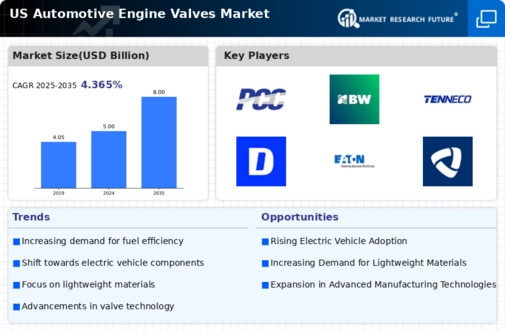Rising Demand for Fuel Efficiency
The automotive engine-valves market is experiencing a notable surge in demand driven by the increasing consumer preference for fuel-efficient vehicles. As fuel prices remain volatile, consumers are gravitating towards vehicles that offer better mileage. This trend is further supported by regulatory measures aimed at reducing fuel consumption. In 2025, the average fuel economy of new light-duty vehicles in the US is projected to reach approximately 25 mpg, which necessitates the use of advanced engine-valve technologies. Manufacturers are thus compelled to innovate and produce valves that enhance engine performance while optimizing fuel efficiency. This shift is likely to bolster the automotive engine-valves market, as automakers seek to meet both consumer expectations and regulatory standards.
Growth of Electric and Hybrid Vehicles
The automotive engine-valves market is witnessing a transformation due to the growth of electric and hybrid vehicles. Although these vehicles utilize different propulsion systems, the integration of internal combustion engines in hybrid models still necessitates the use of traditional engine valves. The US market for hybrid vehicles is projected to reach approximately 1.5 million units by 2026, which could lead to increased demand for engine-valve components. Furthermore, as manufacturers strive to enhance the efficiency of hybrid systems, there is a potential for innovation in valve technology that could cater specifically to these applications. This evolving landscape presents opportunities for the automotive engine-valves market to adapt and thrive amidst changing vehicle dynamics.
Increased Vehicle Production and Sales
The automotive engine valves market is set for growth due to increased vehicle production and sales in the US. As consumer confidence rises and economic conditions improve, vehicle sales are expected to rebound, with projections indicating a growth rate of around 4% annually through 2026. This uptick in vehicle production directly correlates with the demand for engine components, including valves. Manufacturers are likely to ramp up production to meet this demand, which could lead to economies of scale and reduced costs. As a result, the automotive engine-valves market stands to benefit from this upward trend in vehicle manufacturing, positioning itself favorably for future growth.
Technological Advancements in Engine Design
Technological advancements in engine design are significantly influencing the automotive engine-valves market. Innovations such as variable valve timing (VVT) and direct fuel injection are becoming increasingly prevalent in modern engines. These technologies require specialized engine valves that can withstand higher pressures and temperatures, thereby enhancing performance and efficiency. The market for VVT systems is expected to grow at a CAGR of around 8% from 2025 to 2030, indicating a robust demand for compatible engine-valve solutions. As manufacturers continue to invest in research and development, the automotive engine-valves market is likely to benefit from the introduction of more sophisticated valve designs that cater to the evolving needs of high-performance engines.
Regulatory Compliance and Emission Standards
Regulatory compliance and stringent emission standards are pivotal drivers for the automotive engine-valves market. The US government has implemented various regulations aimed at reducing vehicular emissions, compelling manufacturers to adopt advanced technologies in engine design. The Corporate Average Fuel Economy (CAFE) standards, which require automakers to achieve an average fuel economy of 54.5 mpg by 2025, are particularly influential. This regulatory environment necessitates the development of engine valves that can support cleaner combustion processes and reduce emissions. Consequently, the automotive engine-valves market is likely to see increased investment in R&D to create valves that meet these stringent requirements, thereby enhancing their market potential.





















Leave a Comment